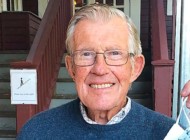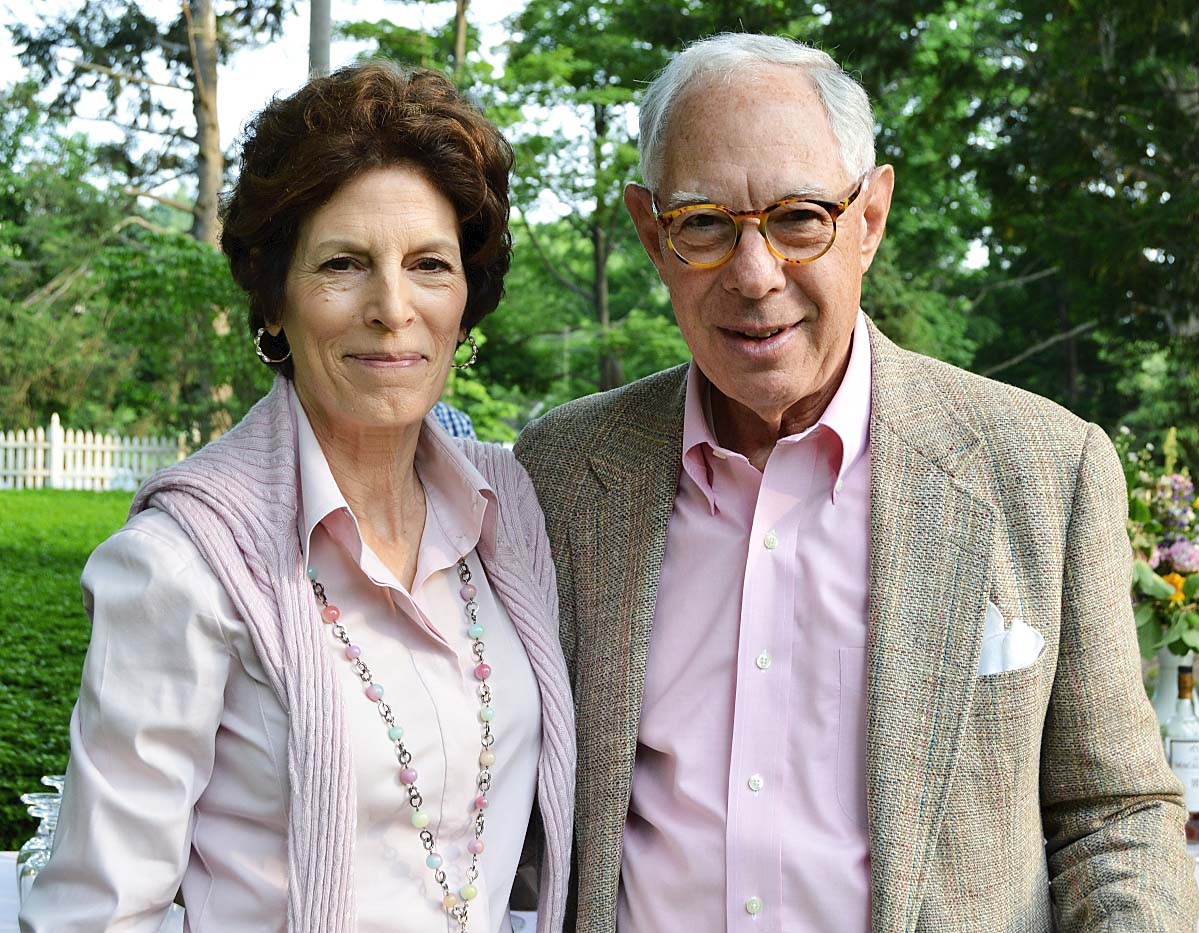
Coco and Arie Kopelman, June 2015.
Compiled by Madelia Hickman Ring
NEW YORK CITY — Arie Leonard Kopelman, former president and chief operating office at Chanel, and, for 23 years, the chairman of The Winter Antiques Show, passed away on Monday, October 7, at his home in Manhattan at the age of 86, from pancreatic cancer.
Arie was born in Brookline, Mass., on September 23, 1938, one of three sons of Frank and Ruth (Koritzky) Kopelman. His father, who immigrated to the United States from Lithuania as a child, attended Harvard Law School and became a district court judge at the age of 27; his mother was a philanthropist who at one time sat on the board of the Dana-Farber Cancer Institute in Boston.
Arie went to school at Boston Latin School and graduated from Williston Academy (now Williston Northampton School) in 1956. He went on to study medicine at Johns Hopkins University but changed course to study art history, graduating in 1960. He received an MBA from Columbia Business School; a training program at Proctor & Gamble followed with a career at P&G that lasted three years.
Arie left P&G to join ad agency Doyle Dane Bernbach as an account executive. For the next 20 years, he rose through the ranks of vice chairman and, ultimately, to general manager. His clients included JB Liquors, Heinz Ketchup and Chanel, one of his biggest accounts.
In 1995, Chanel’s owners, brothers Alain Wertheimer and Gerard Wertheimer, hired him as the luxury brand’s president and chief operating officer in the firm’s New York City headquarters; a year later, he was also managing Frederic Fekkai Beaute in the US.
Arie’s marriage to Corinne “Coco” Franco undoubtedly helped win him the position at Chanel, saying Alain Wertheimer once told him that he “would never find another man married to a woman named Coco.”
By the time Arie got to Chanel, the brand had two boutiques and a reported annual revenue of $357 million; when he retired in 2014, there were 17 retail stores in the US and sales were tallied at $7 billion.
He is credited with expanding Chanel’s skincare, fragrance, cosmetics, eyewear and accessories lines. During his tenure, new fragrances were introduced and a commercial for the firm’s venerable fragrance — Chanel No. 5 — was running on MTV. A newly designed retail format and targeted outreach to new customers helped expand the brand, as did strong relationships he helped forge with retailers and magazine publishers.
Arie’s involvement with The Winter Show (known at the time as The Winter Antiques Show) began in 1982, when, to improve educational opportunities for disadvantaged youth, he joined the board of East Side House Settlement. By 1986, he was on the show committee under chairman, Mario Buatta. In 1995, he was co-chair with East Side House trustee, Louis W. Bowen, but went it alone from 1996, following Bowen’s retirement.
In an interview that ran in this publication in 2018 (“Arie L. Kopelman Exits The Winter Antiques Show, Heart In Hand”), he told Laura Beach, “The first thing I did was create a dealers committee. Without dealers, there is no show. I wanted to be a listener. I came from an operational kind of background, so I could bring some discipline strategically and executionally to the party. I wanted to market the show with more advertising and figure out who the corporate sponsors were so there was enough money to have a substantial ad game. I knew how to put together dealers who would energize the whole, make it more than the sum of the parts. Of course, I had great people helping me.”
One of those helping him was Catherine Sweeney Singer, who was the executive director of The Winter Antiques Show from 1994 to 2018; during their mutual tenure, she helped Arie enact many changes in the show. In addition to establishing a dealers committee, he made vetting an indispensable part of the show, instituted loan exhibitions, increased sponsorships, introduced a $5,000 preview party ticket and raised millions for East Side House.
In 2018, Arie became the chairman emeritus of The Winter Show and was awarded East Side House Settlement’s first Heart in Hand award for public service.
Arie was involved with numerous nonprofit organizations and charities throughout his life in addition to that of East Side Settlement House. Appointed to the United States Holocaust Memorial Council by President Ronald Reagan in January 1989, he also served on Columbia Business School’s board of overseers, and the boards of St Bernard’s School for Boys in Manhattan and the Municipal Arts Society. He was a founding member of the Upper East Side Historic District and president of the Nantucket Historical Association; in 2000, the New York Landmarks Conservancy named him a Living Landmark. He was on the board of the New York City Ballet while his wife, Coco, was on the board of the School of American Ballet.
Arie was remembered by Chanel colleagues and others as an “exceptional” and “visionary leader,” a “passionate philanthropist” who had “a fabulous sense of humor.”
Arie’s daughter Jill Kargman, wrote in her book, Sometimes I Feel Like A Nut, “My dad did stand-up comedy to put himself through business school and he instilled in us a value system based on good times and cackles aplenty.” At one point, he considered a career in stand-up comedy but knew that his father didn’t approve; in a 2013 interview with Women’s Wear Daily, he said, “I like to joke that [my father] came up with the magic word: ‘disinheritance’ and doing lounge acts in Rochester didn’t seem too exciting.”
Following his retirement from Chanel, Arie and Coco split their time between residences in Nantucket, Mass., Indian Wells, Calif., and New York City.
Arie was predeceased by his parents, fraternal twin brother David and younger brother, Robert. In addition to his wife of 52 years, Arie is survived by his daughter Jill Kargman and son-in-law, Harry Kargman; son Will Kopelman and daughter-in-law, Alexandra Michler and six grandchildren.
Arie Leonard Kopelman (1938-2024) In Memoriam
Compiled By Madelia Hickman Ring
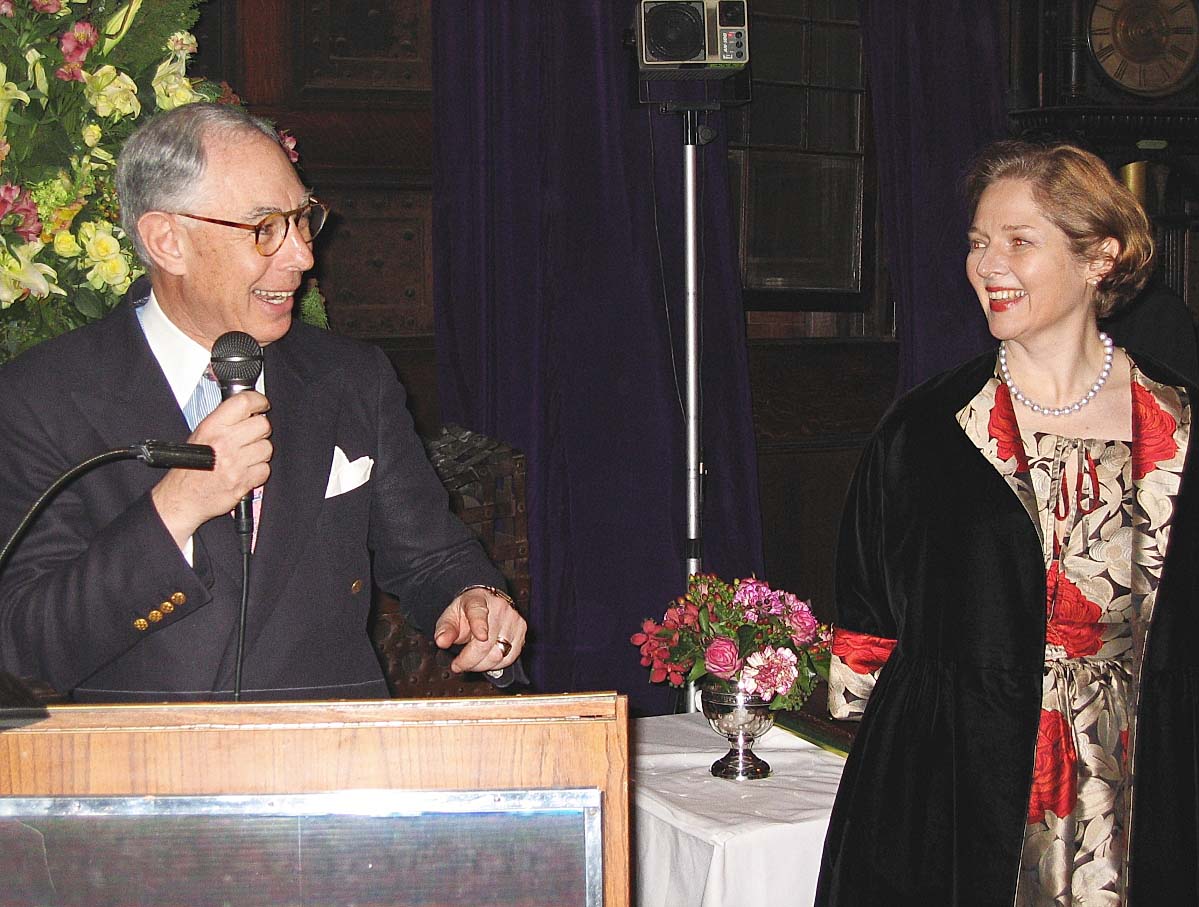
Arie Kopelman & Catherine Sweeney Singer in an undated photo.
“Kopelperson here” was how Arie often answered my phone calls, with a pleased-to-hear-from-you tone, followed by a teasing “ah, it’s the Great Communicator” (as I only called him when scheduled or urgent). His reply to “how are you”? was always “nevvah bettah” delivered with the Boston twang he often trotted out for comic effect at meetings. Arie was a master opener, knowing that to get ‘em laughing was an effective warmup. Above all, he was determined that our committee meetings with volunteers who donated their time to The Winter Antiques Show and its beneficiary, East Side House Settlement, should be fun.
In one-on-one meetings, Arie’s opener was personal: he asked about family and shared recent photos of his (especially the “munchkins,” his now six grandchildren), or a recent addition to his collection. Whether in group or private meetings, Arie was upbeat and enthusiastic, convincing us that these meetings were the favorite part of his day. He truly enjoyed the year-round planning for The Winter Antiques Show, and the respect for him at Chanel extended to the VIP treatment of all who met in Arie’s office or boardrooms there.
We first met on Saint Patrick’s Day in 1994, when my surname was Sweeney, so Arie thought it lucky. I had been in the art business — in magazine startups — for a dozen years and knew that The Winter Antiques Show’s manager and deputy chairman had resigned on closing day that January. Having attended the show since the 80s, I had watched the changes and was aware of some of the challenges. With no real competition for nearly four decades (the show celebrated its 40th year in 1994), the show now had a rival. The glamourous 5-year-old International Show, held in October at the Armory, boasted exhibitors from around the world and was, most importantly, a vetted show — a first in the United States. The Winter Antiques Show had responded by introducing vetting in 1993; vetting meant that buyers could “shop with confidence” as each piece exhibited had been reviewed by a committee of experts.
At that first meeting after sharing interests, academic and other — (in 1994 I was in the graduate program at New York University’s Institute of Fine Arts; Arie had studied art history at Johns Hopkins and was passionate about historic preservation), Arie asked what I would do to “fix” the show. We discussed that The Winter Antiques Show should take advantage of its American roots and build a core of Americana and folk art exhibitors — something that the International Show lacked. I suggested that the occasional museum loan exhibitions become an annual feature, showcasing American collections. Finally, we agreed that the show would benefit from an aesthetic makeover, transforming it from the International’s schmatte-clad sibling to an elegant, ascendant phoenix (apt, as the phoenix perched atop a Federal mirror at MFA Boston was the show’s emblem).
We proposed these ideas at the next committee meetings; Arie’s enthusiasm and trust helped implement them. Arie did not issue commands or give assignments; he made suggestions and loved to “tweak” an idea, a logo, even a show floor plan to improve it. While he was my “boss” (and enjoyed being called that), he treated me as a colleague, with a happily conspiratorial, “we’re in this together” stance.
In spring 1994, Arie hosted cocktails at the Century Association for the exhibitors. Thirty minutes into the reception, Arie took the podium, introduced me, and handed me the microphone — unrehearsed — for me to conduct a town hall meeting to hear the concerns, complaints and suggestions from the (mostly) disgruntled dealers. As I had not yet overseen the show, I took none of the gripes and attacks personally and just listened (while taking notes). Arie and I launched our synergy that evening, for which I earned an “iron fist in velvet glove” moniker. Arie was supportive and united when we had to solve thorny issues and I well understood that key to my role was supporting Arie as chairman, ensuring that he was integral to and consulted on the Show aspects that mattered most to him.
Arie’s passion for the show focused on its content and marketing. Content began with the exhibitor “mix” (over time, we strengthened the Americana core within a show that typically had more than 25 disciplines/vetting categories); range of material (Arie insisted that the show be thoroughly sprinkled with “buyable” pieces); and quality (see: vetting). Content included the loan exhibition (for which we raised dedicated funding) and the show’s décor to increase the show’s “destination” appeal.
Arie knew how to get priceless publicity. Beyond his focus on and approval of the show’s paid advertising campaign (which included the back page of the Sunday Styles section of the New York Times before the opening night party), Arie leveraged his experience and contacts in myriad ways, from the several years that the show’s invitation was engraved by Tiffany & Co., to the gift umbrellas for preview guests and so much more. The 1996 loan exhibition (Arie’s idea, “My Favorite Chair” with two dozen chairs lent by collectors) was featured in the New York Times’ Sunday magazine — a press preview of incalculable value.
Arie cared deeply about the show’s exhibitors and beneficiary. He was a dealmaker, often asking the price for a “scholarship kid” when negotiating a price or fee — or when soliciting underwriting to enhance the show. For the show’s 50th anniversary, Arie wanted to have a celebration for the exhibitors in the “Tiffany” (Veterans) Room at the Armory during the show. Tiffany underwrote the party and included Tiffany gifts engraved with the show’s phoenix for the exhibitors. For the show’s 60th diamond year, prompted by an exhibitor’s offer to lend Queen Victoria’s diamond and sapphire tiara (designed by Prince Albert and depicted in a Winterhalter portrait), one of Arie’s colleagues lent jewelry cases for a centerpiece exhibition of iconic diamond pieces from several luxury jewelers. Through exhibition fees from the jewelers, the diamond display netted six figures for East Side House.
Shopping for exhibitors was one of Arie’s passions. With suggestions from the dealers committee and others, we would decide what disciplines and which dealers might enhance the show. In several cases, Arie courted a potential exhibitor for years until she/he finally said yes to participating. For a decade, we invited no new paintings exhibitors, as Arie wanted to build the “antiques” component of the show, especially in American material. We invited the best dealers in folk art, Shaker, Arts and Crafts, samplers and textiles, ceramics, silver and glass, Native American, Nautical, Aesthetic Movement and more. More than three dozen new exhibitors in American material debuted at the show, and most continued for years. We increased the percentage of exhibitors in American material (including both fine and decorative arts) to about a third of the show and maintained that level through the show’s 60th year.
Along with an increase in Americana, over 25 years we introduced Midcentury Modern, illuminated manuscripts, antique wallpaper, European folk art, Twentieth Century and contemporary art (within specific guidelines), Italian glass, artists’ jewelry, Old Master drawings and paintings and European sculpture, among others. The show’s diversity and focus on quality continue, supported by a strong cohort of more than two dozen exhibitors who have been loyal to the show for decades.
Living a convenient one block away from the Park Avenue Armory, Arie enjoyed checking on the show during setup for the big “reveals,” as exhibitors searched for and saved pieces all year long to feature in January. Arie enthusiastically previewed the show, greeting exhibitors, show staff, security and union installers in a walkthrough-reunion with several stops to examine something that caught his eye. He would visit several times during the weeklong installation and was onsite for the final vetting reviews to help resolve any disputes. Through 2004, when Arie’s “day job” was CEO and president of Chanel USA, he and Coco would attend the Thursday Opening Night Party and depart Friday for the Paris fashion shows, returning the following weekend. We scheduled two or three hours on closing Saturday or Sunday to walk the show together, thank the exhibitors, and make notes for the next year.
Arie’s heart (his favorite folk art motif) and core were his love for his family, framed by pride in his and others’ achievements, and infused by generosity with his time and ideas. I am honored to have worked for, and with, Arie for 25 years and to have had his trust and support in making the show a success for all. Arie’s leadership and care for The Winter Antiques Show render him one of the most powerful and effective “influencers” ever in the field — a designation he surely would appreciate.
Catherine Sweeney Singer
New York City
Arie was an extraordinary man — one of a kind in all the best ways. We worked together on The Winter Show for well over 20 years and I consider my time with him a great gift, for which I will always be grateful. He inspired me, taught me, constantly made me laugh and always came forth with the most spot-on advice which was driven by keen intuition and wisdom. My favorite times were sitting on the floor of his apartment going over designs, floor plans, potential ads, color combos — he had a great eye — and the ritual of walking down the aisle of the show to warmly greet exhibitors, often with a joke or a personal question about family, or a deep discussion of the provenance or aesthetics of something in a booth that piqued his curiosity. He drew people to him by genuinely caring for them. Much has been written about Arie’s devotion to his own family, his comedic talent (a wicked mimic!), his joie de vivre, his continuous optimism to the very end and, of course, his brilliance as Chanel’s leader. To me, compassion was one of Arie’s greatest qualities. So, it is fitting that he collected objects with the heart motif, and that in 2018 he was awarded the first (and only) Hand in Heart Award by East Side House Settlement.
Lucinda C. Ballard
Co-chair, The Winter Show
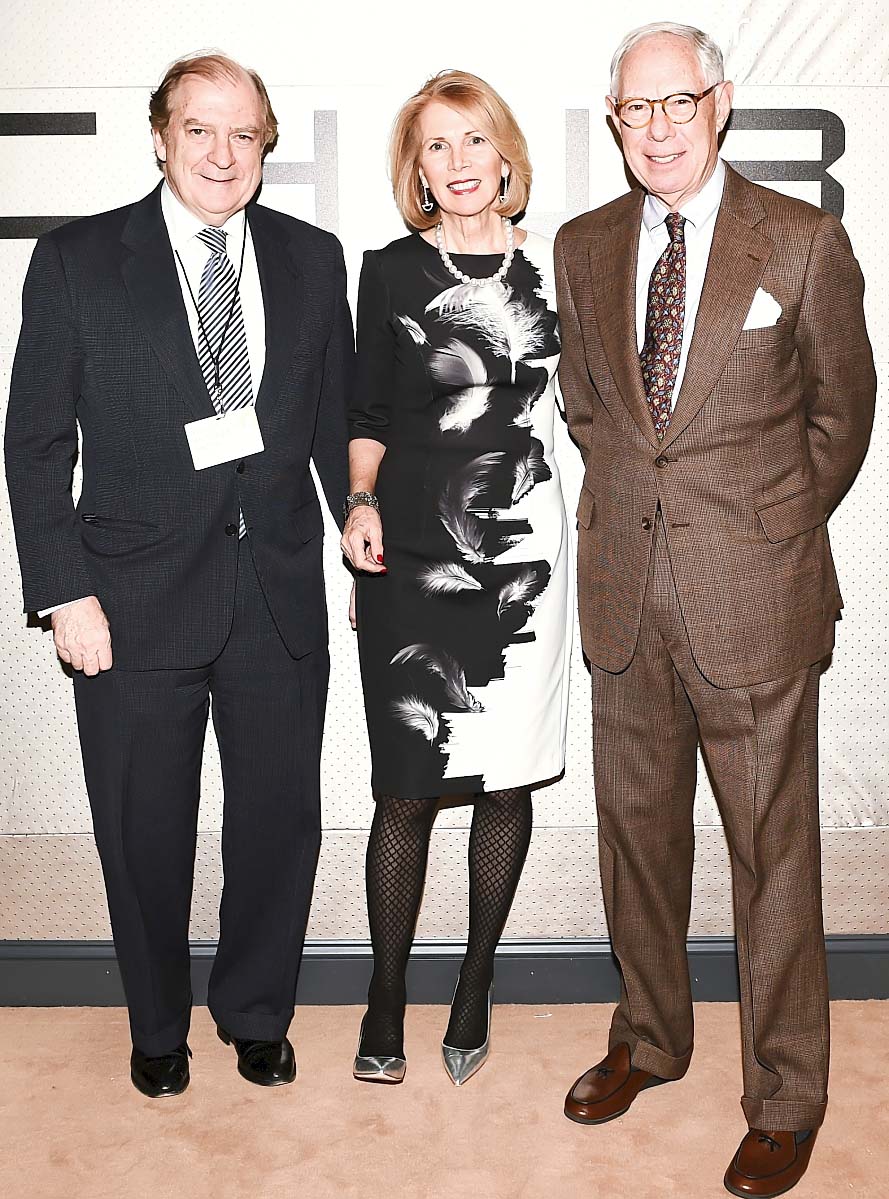
From left, The Winter Show co-chairs Michael Lynch and Lucinda Ballard, with Arie Kopelman, in 2018.
It is difficult to capture in a few words how special Arie Kopelman was. As we have heard from so many others, he really did light up a room when he entered it. The big smile, the humor, it was all part of Arie.
I got involved with The Winter Show (then called The Winter Antiques Show) and with East Side House Settlement through my friendship with Arie. One of my memories of him will be his walking through the armory the day or two before the Opening Night of the show as the dealers were setting up their booths. He spoke with all the dealers, asked questions about their booths and the items that would be on sale in approximately 48 hours. There were also questions on how their families were and what trips they had taken in the recent past.
Another lasting memory will be the lunch that we would have at the show’s caterer eight to 10 weeks before opening night at which we would taste samples of the various food items that were available to be served at the Opening Night of the show. It would be a huge understatement to say that Arie liked food and that he was quite particular in how he thought that the food should be prepared. Whether it was adding a bit less salt or seasoning to an item, Arie always had a comment on the food.
And those of us who knew him well, knew that to present a sample of any type of food that had even a minuscule amount of cilantro, was completely forbidden.
We extend our condolences to Arie’s wonderful wife Coco, his daughter Jill and son Will and his grandchildren. He was a wonderful person and a great friend, and I will miss him keenly.
Michael R. Lynch
Co-chair, The Winter Show
Arie was the definition of a true gentleman. He had a way of making whomever he was speaking with feel as if they were the most important person in the room. He always wore a smile on his face and had a twinkle of mischief in his eye. I had met Arie at various times over the years at the show, standing outside his granddaughter’s school when he was there to pick her up (his granddaughter and my daughter were in the same class), and then in an interview to join The Winter Show. Although Arie became Chairman Emeritus as I joined, he remained very much the heartbeat of The Winter Show and became, in many ways, a mentor to me. His deep passion for the decorative arts and the relationships he had with the dealers was evident in every conversation we had over the past six years. He would call me to tell me about a chair he had seen on his travels — giddy as a schoolboy. I loved our “teas” at his home and our lunches at Donahue’s. Arie was always quick with a joke and he would often try to bring others along on the ride. He was an inventive story teller. One of the things that I admired most was his dedication to his family. We never had a meeting or a call when he didn’t fill me in about his grandchildren’s myriad accomplishments, about Jill, Will and Coco, too. He adored his family, and was never brighter than when he was with them or talking about them.
Helen Allen
Executive Director, The Winter Show
It was Arie who first invited us to exhibit at The Winter Show, 25 years ago, and remained a loyal supporter ever since, (in fact he visited our gallery in London again this past summer).
A ready smile, an easy charm and a well-cut suit were the first things you noticed about him, yet behind these there was a passionate enthusiast and boundless energy.
A collector himself, he understood the intricacies and subtleties of the antiques industry and with his drive and vision he helped to bring around changes and move The Winter Show into the changing market of the Twenty-First Century.
With his background in fashion, he understood marketing and presentation and wanted to help make even the finest and rarest works visible, accessible and appreciated by a wider public.
He followed the industry with care and diligence. He promoted the show with informed intelligence, and a genuine passion, peppered with a sharp wit and good humor. Even after he retired as chairman of the show, he continued to visit frequently, often bringing friends and colleagues around, and sharing his infectious enthusiasm for the pieces he liked with people from all walks of life.
Arie always “worked” the show and supported his dealers.
As the show moved into the second week the suit would be replaced by chic casual clothes and the polished shoes for trainers. The jokes became a little longer, often a little bawdier, and he loved to learn what had been going on and what had been selling.
The gossip aside, he kept a close eye on the mood and the changes in taste. He also talked warmly of his family and shared tales and images of his grandchildren, he discussed pieces he had added to his collection and things he’d missed and told stories of people and places he enjoyed.
I worked closely with him on a few occasions and always found him to be fair and decisive. He had multiple interests, an easy manner, an approachable warm nature and an admirable professional ethic. He always found time to listen and was never short of a story. He will be greatly missed.
Robert Young
London
Arie Kopelman was my friend.
Our introduction came in January of 1997, on the floor of The Winter Antiques Show, where we were exhibiting for the first time and Arie was chairman. His broad smile and enthusiastic reception eased our first-year jitters and at once made us feel a part of The Winter Show family. His enthusiasm for Americana, especially folk art, brought him to our booth frequently and gave us the opportunity to spend a good deal of time talking about the material. It was soon apparent that not only did he have a love of the objects but also knowledge and a very good eye for the best.
Over the course of the next 23 years, I enjoyed the annual event at the armory and Arie’s many visits. I was often awed by his incredible memory and eye for detail. If we opted to bring an item that had not sold in a previous year, Arie would not only recognize it but proceed to describe the booth and its placement from before! We tried very hard to never repeat an unsold item knowing Arie would call us out. He was not one to pass out insincere compliments so when he told us one year that our booth was the best presentation of Americana he had ever seen at The Winter Antiques Show I felt truly anointed!
During my years on the Dealers Committee, and especially as chairman, I had the opportunity to work more closely with Arie and came to appreciate his true devotion and love of the show and the charity it benefited, East Side House. He was extraordinarily successful in his career but often expressed that his true passion was design and decorative arts, often remarking on his close friendship with designer Mark Hampton. And he loved to jest that he planned to open a shop on retirement to give me some competition, which would no doubt have been formidable.
Fortunately for him, he had three marvelous homes to fill and the understanding of a supportive wife who was good at providing the gentle restrain that any collector needs to avoid the pitfalls of a hoarder. On more than one occasion, when he was eager to make a purchase, I would say “why don’t you run it past Coco.”
It was such a treat to sell to Arie and it was never over with the purchase. There would inevitably be many discussions about why that particular piece was “best of kind” and his analytical observations as if I hadn’t looked at it before selling it to him. But of course, it was never the “best” until after he negotiated the price. I’ve known more collectors than I could count but none was more passionate in the love of beautiful objects than Arie. And he enjoyed telling how his daughter, Jill, would tease him about the weathervanes, threatening a “weathervane intervention!” All of this with that smile and twinkle in the eye.
After leaving The Winter Show, we opened our shop on 72nd Street and this provided the perfect opportunity to stay in regular contact with Arie, as he was, by then, retired from Chanel. Many an afternoon the buzzer would ring and Arie would stride briskly to the door with his big smile and warm greeting to spend an hour or two looking at every item then taking a seat to share personal stories and a little gossip. When schedules permitted, we would meet for lunch; sometimes at his club but more frequently at Donahue’s, his favorite haunt on the Upper East Side and a regular of The Winter Show dealers.
One memorable day, I was visited by another collector friend, Jerry Lauren, who would walk down from his office a block away on Madison. About 30 minutes into the visit, Arie appeared. Of course, he and Jerry were old friends and the afternoon soon turned into a vaudeville routine of the two bantering with insults and compliments that had me in stitches. Jerry played straight man to Arie as if they had been on stage for years, a calling that I later learned had been an early avocation. His impersonations were flawless and those of fellow dealers were priceless. I hope he had one of me as well.
Arie’s last visit was just two weeks before he died. Gone was the brisk walk, now aided by a walker, but once inside he proceeded to examine the latest offerings and even made a purchase — the piece had a heart of course. We sat and talked about objects and then his illness and then his impending death. We had shared such confidences before, so this was not only special, but almost necessary. Arie was both aware of and truly grateful for the many blessings of his life, most especially his loving and devoted family. As usual, he left me with a special lesson. And he was ready for the next adventure.
Arie Kopelman was my friend. And for that I am grateful.
Patrick Bell
New York City
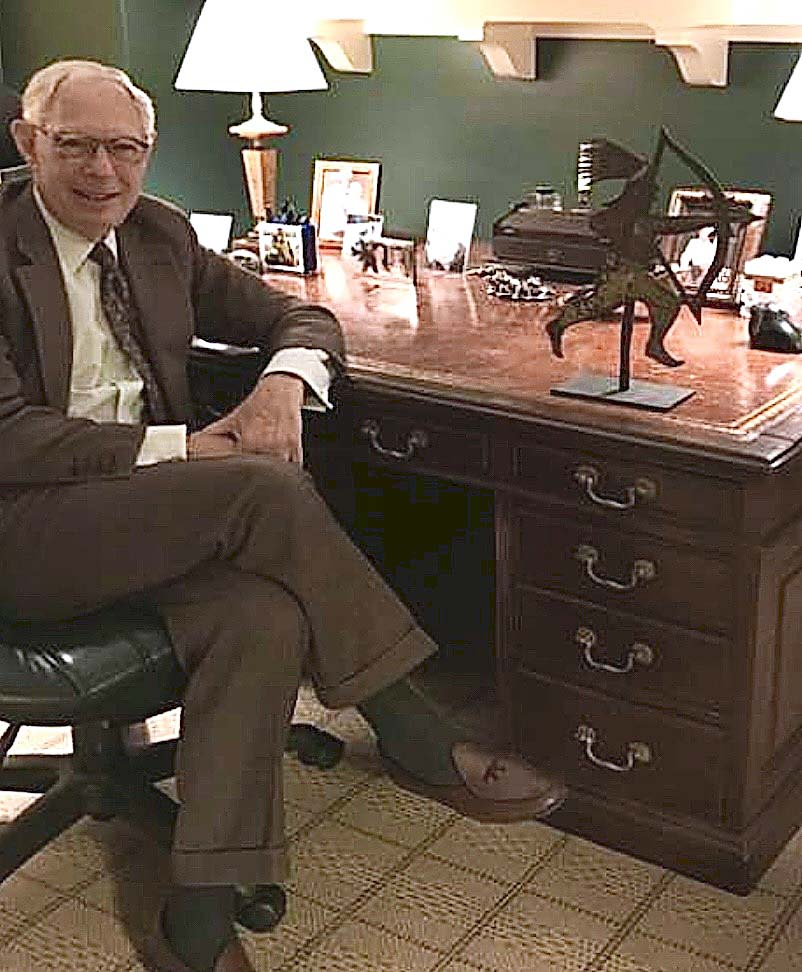
Arie Kopelman with a small painted Indian weathervane he purchased from David A. Schorsch at the 2015 Winter Show. Photo courtesy David A. Schorsch.
We were saddened to learn of the passing of Arie Kopelman. In addition to his legacy as a successful businessman and philanthropist, he was an influential advocate for the antique business. My first personal memories of Arie and Coco Kopelman took place, appropriately, decades ago at an opening night preview party of The Winter Antiques Show at the Park Avenue Armory. It was in 2002, when we were invited to exhibit at the Winter Antiques Show, that our friendship began. In his capacity as the chairman of the show, Arie took a hands-on approach. He was fully committed to its success and supporting the work of East Side House Settlement. The show and charity benefited enormously from Arie’s considerable business experience, boundless energy and generosity of his time and resources. When Arie took on the responsibilities as chairman of The Winter Antiques Show, I believe in 1995, it had conceptually changed little since its inception in the 1950s. Arie’s goal was to bring The Winter Antiques Show into the Twenty-First Century by introducing new categories and an expanded dateline to attract a broader and younger audience to “The Winter Show,” as it came to be known. During his tenure at the show, Arie was a devoted and fatherly presence who always exuded an optimistic enthusiasm. He was a real objects person with a passion for the works displayed at the show. To know Arie was to share in his good humor, joy of life, warmth, infectious smile and distinct Boston accent. He was also quite affectionate and demonstrative, often greeting friends with a big hug. Arie was incredibly youthful, almost ageless, with a personality, appearance, physique and sense of style that belied his chronological age. It is hard to believe that he was really 86 years old. A few years ago, when reading an online interview of Arie for Haute Living, I was pleased to learn that one of Arie’s favorite items displayed on his desk was a small painted Indian weathervane that he purchased from our booth at the 2015 Winter Show. Over our years at the show, Arie became a member of our collective family. To my daughter, Lizzie, who was just 3 years old when we began exhibiting at the show, Arie was a larger than life and glamorous figure who was always engaging, thoughtful and entertaining in their interactions. Upon hearing the sad news, Lizzie immediately reminded me of Arie’s kindness to her as a child growing up at the show. It is fitting that the last time I saw Arie was at the opening night preview of the 2024 Winter Show, at the same venue where we had met.
David A. Schorsch
Woodbury, Conn.
Arie was a remarkable man whose drive and dedication helped make The Winter Show the “Greatest Show on Earth.” As a Winter Show exhibitor, I am proud to be a part of his ongoing legacy.
Arlie Sulka
New York City
Arie loved prank phone calls. His favorite was a rabbi with a long, made-up name and a heavy Yiddish accent. Once, he pretended to be a French miniature collector on holiday in Philadelphia who wanted to see my collection and “purchase as many pieces as possible.” Arie was dismayed that nobody ever fell for his calls. I never told him that his caller ID said “Chanel USA.”
Elle Shushan
Philadelphia
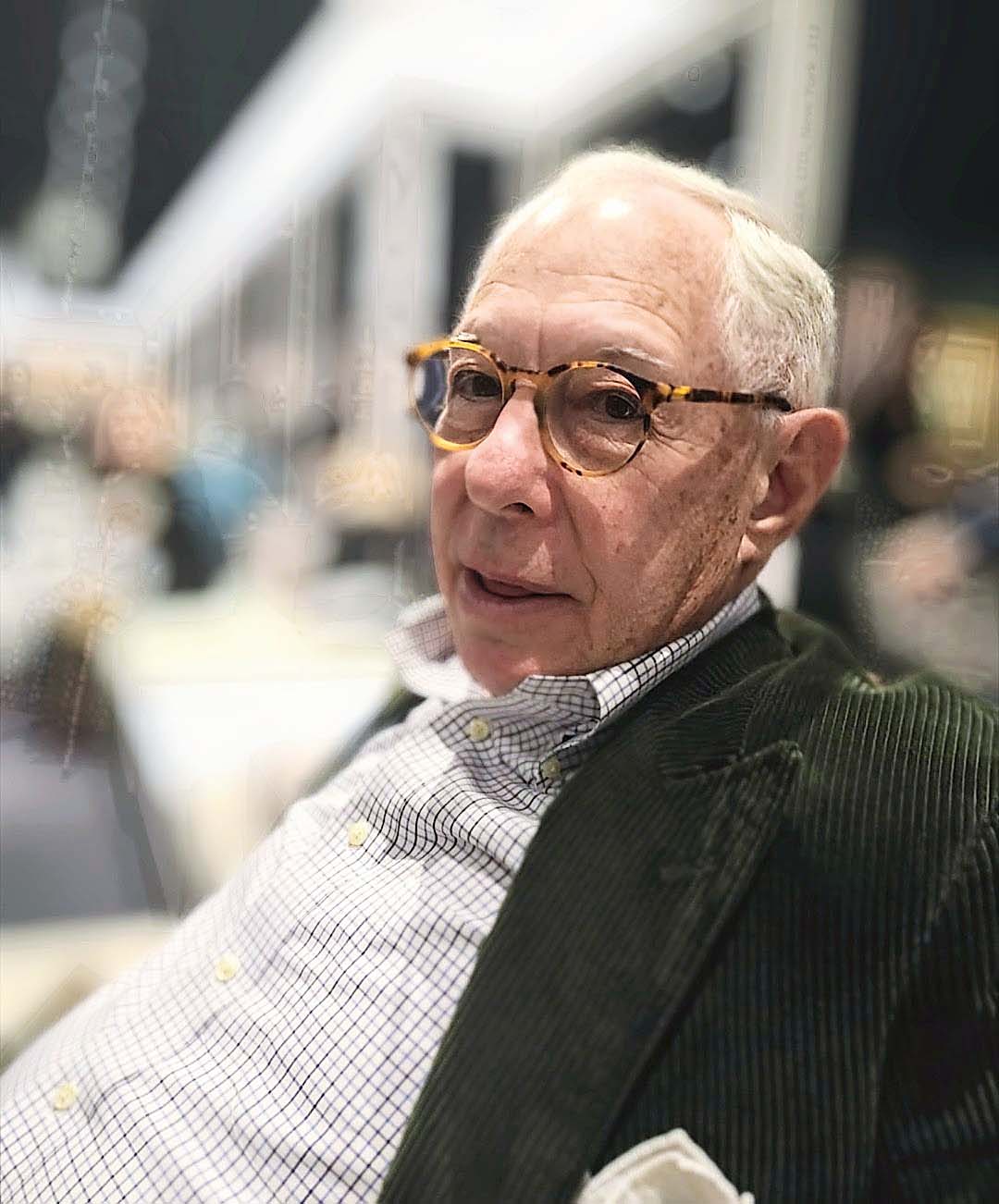
Arie Kopelman at Elle Shushan’s booth at the 2019 Fall TEFAF at the Park Avenue Armory. Photo courtesy Elle Shushan.
It’s a big loss for the field. Arie sublimated art collecting and ran The Winter Antiques Show like he probably ran a Chanel board meeting: he was thoughtful and purposeful.
He was so enthusiastic about American art, about ALL the arts. For me, to have someone who was in fashion, who was so debonair and global and have enjoyment in my field was very thrilling. Despite his very important role at Chanel and in fashion and design, he was very unassuming and approachable. He and Coco were a wonderful couple and they made the art field distinctive and glamorous but in a very gentle and unassuming way.
For all he did at Chanel, I think he was most comfortable in his Nantucket reds and we loved to tease him about them. It shows you how easily he slipped into that world up there; even though he was an arbiter of taste in the fashion world, he made Nantucket reds chic.
John Hays
New York City
Without a doubt, Arie Kopelman’s leadership and guidance were a major reason for The Winter Show’s rise to its current status as the top show in the country. He was very much in touch with what was going on in the trade and developed relationships with the dealers through the years. As a member of the dealer’s committee for almost two decades, I dealt with him often and was always impressed by his insight and knowledge.
Andrew H. Chait
New York City
To me, Arie was a true Renaissance man with a great sense of humor. Who could successfully serve as president and COO of Chanel and act as year-round chairman of The Winter Show, all while being a wonderful husband, father and grandfather? Arie Kopelman.
Importantly, he did it all with a sense of humor. When I told him, “You could have been a stand-up comic,” he deadpanned, “Trust me, I wouldn’t have been standing long.”
As a dealer at The Winter Show for nearly 25 years, I had the pleasure of interacting with Arie quite often. He treated everyone — regardless of their socioeconomic status — with the same graciousness. Not once did I see him belittle another human being. Humble, yet gentlemanly, he was a quintessential Twenty-First Century Jimmy Stewart. In the late 1990s, the show’s dealers committee, of which I was a member, gathered at his impressive office at Chanel’s 57th street headquarters for a sit-down. We showed up early and, feeling cheeky, I sat in his comfy chair, put my feet up on his massive desk, and when Arie walked in, I said, “Look, the intern finally showed up, how does everyone want your coffee?” Unsurprisingly, Arie went along with the ruse and soon had us all in stitches laughing.
Arie was equally at home near his place in Nantucket as he was at a New York black-tie event. He lived in the moment and seemed to love every moment. I truly respected the fact that this man, who brilliantly ran one of the largest and most successful luxury brands in the world, found visual beauty and tactile pleasure from the simplest of objects. As he often gravitated towards American folk art, he was definitely a man after my own heart. Arie, you will be forever remembered and sorely missed. Rest in Peace.
Leigh Keno
New York City
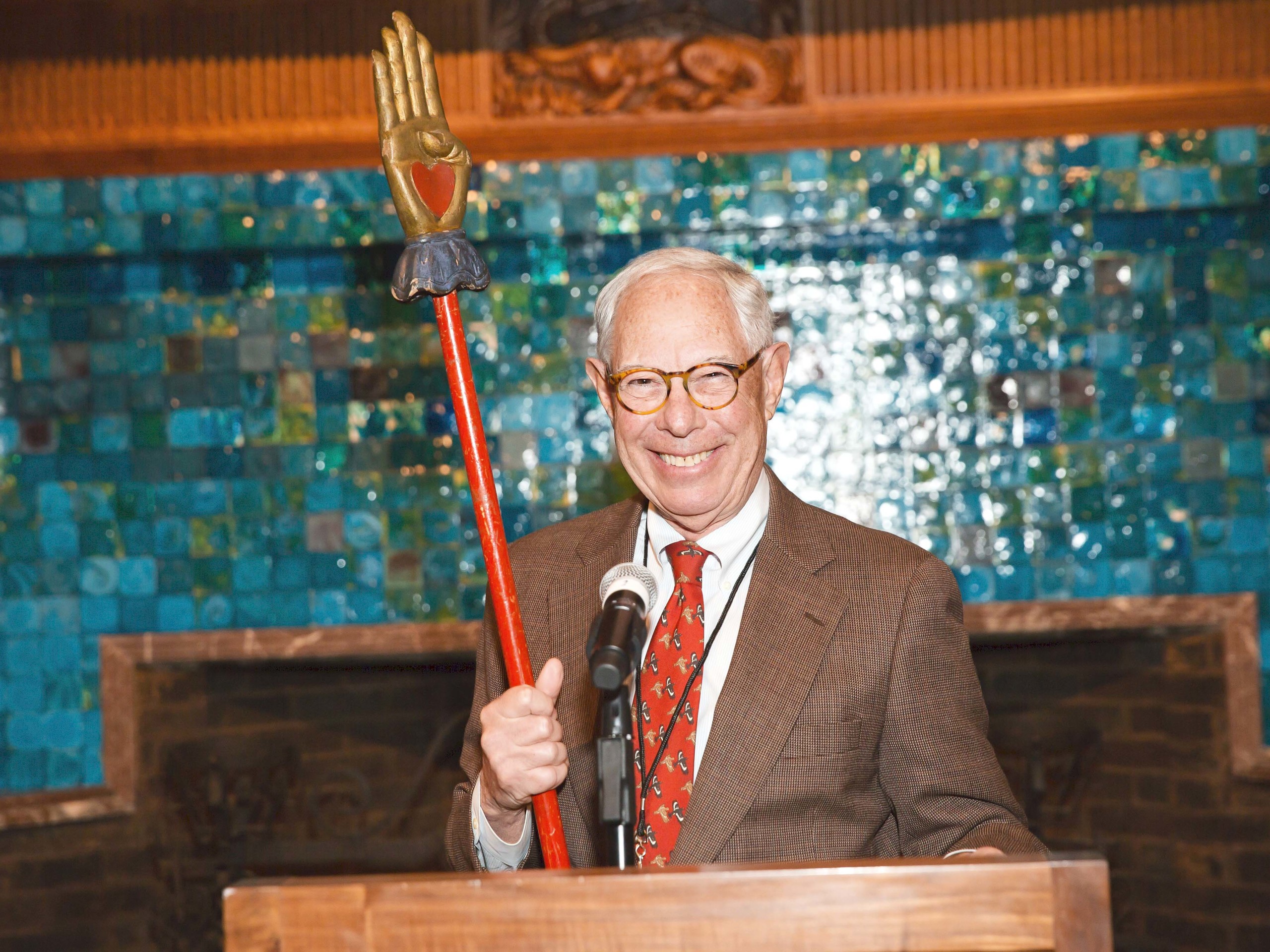
Arie Kopelman with the Heart in Hand award he received in 2018.
Arie was a beloved friend to many in the art and antiques community. He was an ultimate aesthete, a man of great humor and had an insatiable curiosity about the stories that made objects memorable and special. We will miss his friendship, the sparkle in his eye that ignited when discovering a new work of art from across the room, and his unwavering enthusiasm about taking The Winter Show “from strength to strength,” as he always said. We will miss him profoundly and send our love to Coco and their kids whose lifelong friendship to our family means so much.
Stuart, Sue and Liz Feld
New York City
Arie was a wonderful man. I always found him to deftly walk the line between being a dealer advocate and raising millions of dollars for the East Side House Settlement, which is a skillful art to say the least.
He had a wonderful twinkle in his eye when he came into your booth and was interested, sometimes he had a coy smile on his face when he wanted to negotiate a price. He was just a total gentleman; when we joined the show, he and Coco could not have been more welcoming and gracious. When the Winter Show opens this coming January, it will be the first time in my career that he won’t be there on opening night. He will be missed.
Allan & Penny Katz
Madison, Conn.
I first met Arie while helping Jim and Nancy Glazer at The Winter Show. His enthusiasm for the decorative arts ran the gamut from the most extraordinary object to the more modest, always celebrating the finer points of those objects that spoke to him. When I had my own stand at The Winter Show, he always visited to make sure I had everything I needed and always made much of my inventory. He will be greatly missed.
Kelly Kinzle
New Oxford, Penn.
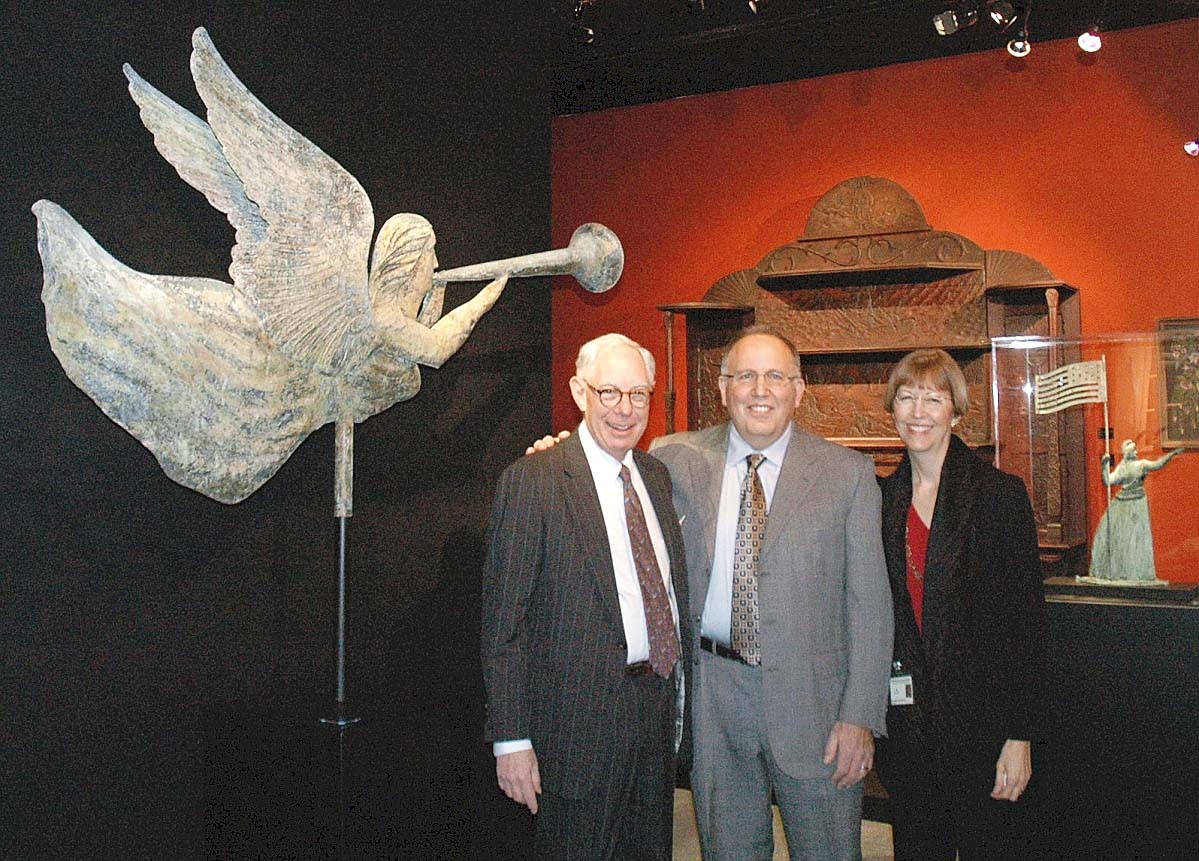
Arie Kopelman, Fred Giampietro & Kathryn Giampietro at the 2011 Winter Antiques Show.
We met Arie and Coco our first year exhibiting at The Winter Antiques Show in the early 1990s.
At the time we were the youngest dealers in the show and were very nervous being dropped into the middle of this event. Arie quickly sensed our uneasiness and made us comfortable and welcome. He will be remembered by us for his friendship and extraordinary generosity.
Fred and Kathryn Giampietro
Branford, Conn.
Arie Koppelman was a BIG picture guy!! He had great vision and a vivid imagination. His creativeness helped to fortify and energize The Winter Show. Arie was passionate about material culture, and while The Winter Show unfolded each January, Arie would comb the floor for examples that would fit into his carefully self-curated collection. Arie will be greatly missed.
Arthur Liverant
Colchester, Conn.
Arie and I often vied for specific pieces. He never forgave me for the Nineteenth Century French wind god weathervanes I purchased at the Philadelphia show one year — he just couldn’t understand how I beat him to the purchase. And even after I explained that I got to the dealer first simply because the vanes were hanging next to the ladies room entrance, a necessary first stop after my train trip from New York City, rather than the proper entrance to the show. Still, he never let me forget this, perhaps the one and only time I beat him to the proverbial punch!
Ellie Cullman
New York City

